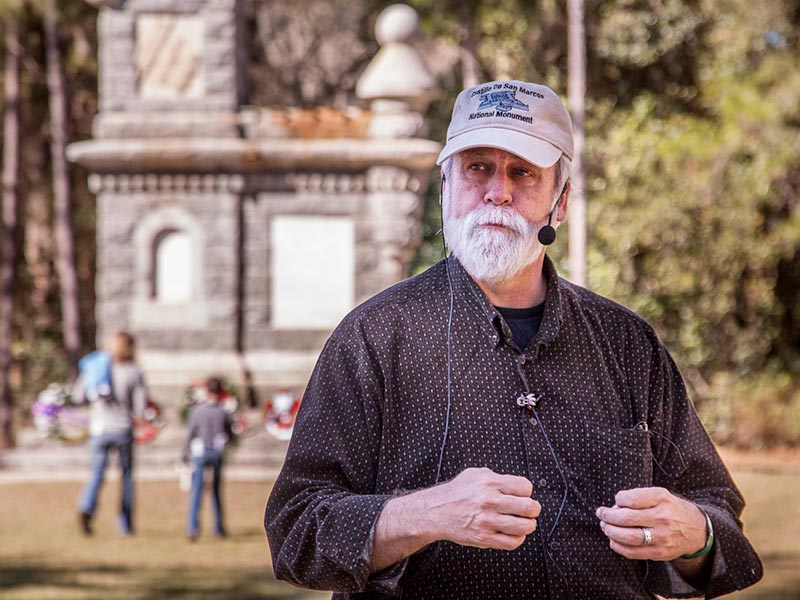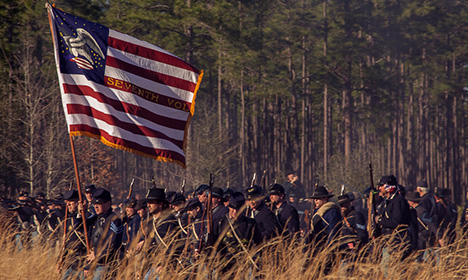
Event Summary
![]() oin Landmark Events historian Bill Potter and our Floridian friend, Evan Soileau as we explore the ancient sites of northeastern Florida, redolent with the sea breezes of the Atlantic and steeped in a providential history that helped create the English civilization that became embedded north of Florida and brought about the abandonment of the outposts of Spain’s Empire in North America. We will tell the stories of the Castillo de San Marcos in St. Augustine and the French Huguenot colony at Jacksonville, Ft. Caroline. We will remember the courageous Reformed settlers who brought the Gospel to the natives of the region and their subsequent extermination by the Spanish for the capitol crime of rejecting the Catholic Church and following the Calvinist Reformation. We will examine the lives and times of fearless conquistadors, colorful pirates, superstitious explorers seeking the Fountain of Youth, and the ferocious no-holds-barred Scots-Irish General Andrew Jackson who seized Florida and would not give it back.
oin Landmark Events historian Bill Potter and our Floridian friend, Evan Soileau as we explore the ancient sites of northeastern Florida, redolent with the sea breezes of the Atlantic and steeped in a providential history that helped create the English civilization that became embedded north of Florida and brought about the abandonment of the outposts of Spain’s Empire in North America. We will tell the stories of the Castillo de San Marcos in St. Augustine and the French Huguenot colony at Jacksonville, Ft. Caroline. We will remember the courageous Reformed settlers who brought the Gospel to the natives of the region and their subsequent extermination by the Spanish for the capitol crime of rejecting the Catholic Church and following the Calvinist Reformation. We will examine the lives and times of fearless conquistadors, colorful pirates, superstitious explorers seeking the Fountain of Youth, and the ferocious no-holds-barred Scots-Irish General Andrew Jackson who seized Florida and would not give it back.
We will begin with a history of development in South Florida, St Augustine in particular, led by visionary Henry Flagler. Evan will lead us on a fascinating architectural tour of St. Augustine that is instructive and entertaining. We will conclude by attending one of the most interesting Civil War reenactments at the scene of the largest battle fought in Florida. A Confederate victory in a strange place of palm trees and swamp grass, the Battle of Olustee took place hundreds of miles from the main theaters of action. There’s something for everyone on this tour!
![]() They’ve done all the work for you! Just show up and enjoy each of the amazing venues, and soak in the Biblical interpretations and rich fellowship. You won’t regret it!” —Jessica K.
They’ve done all the work for you! Just show up and enjoy each of the amazing venues, and soak in the Biblical interpretations and rich fellowship. You won’t regret it!” —Jessica K.
St. Augustine Pirate Museum
Fort Caroline National Memorial
Ponce de Léon’s Fountain of Youth Archaeological Park

History from a distinctly Christian perspective

Historian Bill Potter

Rich Christian Fellowship
![]() Landmark Events does an amazing job at weaving together our Christian heritage with the broader history in an educational and fun way for everyone in the family! You won’t be disappointed!” —Darrell S.
Landmark Events does an amazing job at weaving together our Christian heritage with the broader history in an educational and fun way for everyone in the family! You won’t be disappointed!” —Darrell S.
Tour Highlights
Castillo de San Marcos
The legacy of Spanish conquest still lies embedded in the oldest continuously inhabited place in the continental United States, St. Augustine. Founded on “St. Augustine’s Day” in the liturgical calendar, a great fortress known as Castillo de San Marcos (The Castle of St. Mark) arose, to tower over the settlement both as a protection for the Spaniards defending the frontiers, as well as a potential launching pad for the further conquest of North America.

Pirate and Treasure Museum
The St. Augustine Pirate & Treasure Museum offers an exciting and educational museum experience that transports you and your family back in time over 300 years to Port Royal, Jamaica, at the height of the Golden Age of Piracy. Laden with over 800 real pirate artifacts, including the only treasure chest known to have belonged to an actual pirate – as well as one of only three original Jolly Roger flags left in the world, this museum is incredible!

Flagler College
Built as the luxurious Hotel Ponce de Leon in 1888 by railroad magnate, Henry M. Flagler, Flagler College is considered one of the finest examples of Spanish Renaissance architecture and is listed as a National Historic Landmark today. Among the highlights of this gorgeous building is the grand lobby with its 68-foot domed ceiling supported by eight ornate hand carved oak caryatids and the dining room where 79 Louis Comfort Tiffany Stained Glass windows stream light onto the beautiful hand-painted murals on the walls and ceiling. Hands down, the most beautiful college in the land!

Fountain of Youth
Ponce de Leon’s Fountain of Youth Archaeological Park is the original site of the Nation’s oldest city. Located in the area first explored by Juan Ponce de Leon in 1513 and settled by Pedro Menendez de Aviles in 1565, historic St. Augustine is the oldest successful European settlement in the United States. Colonial America started right HERE, 55 years before the Pilgrims landed on Plymouth Rock, and 42 years before Jamestown! With a long, rich history spanning nearly 500 years, the Fountain of Youth Park will delight and amaze you.

Fort Caroline
Fort Caroline is a reproduction of an attempted French colonial settlement located on the banks of the St. Johns River near Jacksonville. It was established under the leadership of René Goulaine de Laudonnière on 22 June, 1564, following King Charles IX’s enlisting of Jean Ribault and his Huguenot settlers to stake a claim in French Florida ahead of Spain. The Spanish Catholics resented the French Protestants and the colony came into conflict with the Spanish. In September 1565, Pedro Menéndez de Avilés came north with troops from St. Augustine and laid waste to the French settlement, sacking Fort Caroline and executing many of its inhabitants.

Battle of Olustee
We will also attend one of the most interesting Civil War reenactments at the scene of the largest battle fought in Florida. A Confederate victory in a strange place of palm trees and swamp grass, the Battle of Olustee took place hundreds of miles from the main theaters of action. The army of Georgia and Florida Regiments routed an army of New York, Massachusetts and Colored troops—for the Union, the second bloodiest battle of the war per number of troops engaged.

Ribault Monument
The Ribault Monument commemorates the 1562 landing of Jean Ribault near the mouth of the St. Johns River. Ribault was a French naval officer, navigator, and a major figure in the French attempts to colonize Florida. A Huguenot and officer under Admiral Gaspard de Coligny, Ribault led an expedition to the New World in 1564 where he took over command of the French colony of Fort Caroline. Shortly thereafter, he and many of the French colonists were massacred by Spanish soldiers near St. Augustine.

St. Augustine Architecture Walk
St Augustine contains a fabulous variety of architecture ranging from Neo-Renaissance of Memorial Presbyterian Church, to Classic French and English Colonial styles of many homes and capped off with the fascinating home of Eccentric millionaire Frank W. Smith who built Zorayada’s Castle in 1883 based on the Moorish architecture of the Alhambra Palace. Our friend, Evan Soileau, will lead us on an interesting and entertaining stroll through the streets of St. Augustine identifying and analyzing the worldviews displayed in these really unique buildings.

Event Speakers

Bill Potter
An experienced historian and avid bibliophile, Bill Potter combines a lifelong study of American history with an uncommon ability to captivate audiences of all ages as he traces the providential acts of God throughout the ages. Mr. Potter has taught history in high schools and colleges, has led many tours of American and European historical sites and brings to each event a wealth of experience and knowledge. An experienced researcher and writer, Mr. Potter possesses a practical knowledge of antiquarian books, documents, and artifacts and has published several short books and has penned many articles and book reviews for publication. Bill has earned a well-deserved reputation as a man gifted in communicating the story of God’s providential hand in American history. As a father of eight children, he appreciates the necessity of passing on to the succeeding generations the richness of both our regional and national history. He and his wife, Leslie, reside in Virginia.
Event Schedule
Thursday, February 16
| 1:00pm |  |
Casa Monica Hotel Outdoor Fountain 75 King Street, St. Augustine, FL 32084 |
Friday, February 17
| 9:00am |  |
Ponce de León’s Fountain of Youth Archaeological Park 11 Magnolia Avenue, St. Augustine, FL 32084 Fountain of Youth has a nice picnic area if you want to bring your lunch on Friday. They also have a small snack bar on site or you can get something en route to Jacksonville. No food is available at Ft. Caroline. |
|
||
| 1:00pm |  |
Fort Caroline National Memorial (meet at Ribault Monument 1/2 down from visitors center) 13199 W Ft Caroline Park Rd, Jacksonville, FL 32225 —parking available |
|
||
|
4:45pm |
 |
St. Augustine Pirate & Treasure Museum 12 South Castillo Drive, St. Augustine, FL 32084 |
|
7:00pm |
 |
Food, Andrew Jackson, and fellowship—bring your own food & beverage Host Hotel TBA |
|
7:30pm |
 |
Mr. Potter lecture on Andrew Jackson followed by fellowship and quiz with neat prizes! |
Saturday, February 18
| 9:00am |  |
Castillo de San Marcos (meet outside ticket kiosk) 1 South Castillo Drive, St. Augustine, FL 32084 |
| Lunch on your own. Picnic, dine in or partake from food vendors at Olustee Reenactment. | ||
|
||
| 12:30pm |  |
Enter Olustee Battlefield (Reenactment requires a 1-mile shuttle ride from parking area at Baker Correctional Facility to main entrance—20706 US 90, Sanderson FL 32807) |
| 1:30pm |  |
Battle reenactment begins |
| 2:30pm |  |
Battle reenactment ends |
| Note: Times are subject to change. |
Accommodations
We booked some rooms at the Flagler Inn at 2700 North Ponce de Leon Blvd in St. Augustine. for $139 per night , February 15-17. It has been recently renovated and is a very simple, exterior entrance motel in a good location near downtown. There is no block of rooms to book into, but you can call them at (904) 342-7938 or book online here. Note that when you book online the price will be the total price, i.e. $417.00 for 3 nights( $139 per night). You can ask for the same rate that Kevin Turley has if they don’t have offer the $139 and they said they would honor that. Finally, I have a few extra rooms reserved if the lower rate is no longer available, just email me at kevin@landmarkevents.org or call me at (210) 885-9351. ask me if you would like one. If I can help, just holler.
As always, you are free to stay wherever suits your style and budget. Trip Advisor and VRBO are helpful resources for finding a place to stay.

*** If you are planning on staying Saturday night, we suggest you reserve your room as soon as possible as the Daytona 500 NASCAR race is Sunday and there is a big demand for rooms Saturday night. Our tour ends Saturday afternoon at the Battle of Olustee reenactment, which is about 75 minutes north of St Augustine, so many folks continue north toward home Saturday evening.
Study Prep
Key People
- King Ferdinand & Queen Isabella
- Christopher Columbus
- Ponce de León
- Hernando de Soto
- Admiral Gaspard II de Coligny
- Jean Ribault
- Pedro Menendez de Aviles
- Edward Teach
- Sir Francis Drake
- General Andrew Jackson
- Chief Osceola
- General Truman Seymour
- General Joseph Finegan
Key Issues and Topics
- Spanish Empire
- Conquistadors: Missionaries or Murderers?
- Huguenots and the French Reformation
- Fountain of Youth (man’s constant search for immortality)
- Motivations for Exploration: God, Gold, and Glory
- Differences in Colonization Theory: English, French, Spanish
- Role of Piracy in Atlantic Coastal history
- Piracy in the Cinema: Romantic Misfits?
- A Biblical Analysis of Piracy vs. Letters of Marquee/Raiding the Spanish Main
- Florida’s Strategic Role in the Civil War
Bibliography / Recommended Reading List
- Pirates, Puritans, and the Perils of the High Seas, by Captain Charles Johnson and Puritan John Flavel, Edited by R. A. Sheats
- Under the Black Flag: The Romance and the Reality of Life Among the Pirates, by David Cordingly
- Spain in America, by Charles Gibson
- Londonniere & Fort Caroline, by Charles E. Bennett
- Knights of Spain, Warriors of the Sun, by Charles Hudson
- Confederate Florida: The Road to Olustee, by William H. Nulty

- Q: What credible evidence is there that Ponce de Leon was searching for a “fountain of youth.”
A: There is no credible evidence. Spanish historians wrote it back into the history as supposition.
- Q: Why did French Roman Catholic naval Captain Dominique de Gogues set out to kill fellow-Catholic Spaniards in Florida to avenge the death of Huguenot Protestants?
A: The Spaniards had wiped out the Protestant colony because they were also French, and they wanted no European interlopers threatening their plans to colonize North America, be they Protestant or Catholic. De Gogues was a proud Frenchman who hated Spaniards.
- Q: Why did Edward Teach wear lighted candles in his beard?
A: Better known as “Blackbeard,” it gave him a more ferocious aspect to frighten his enemies and enhance his reputation.
- Q: Why did the coquina shell façade of Fort San Marcos prove so effective in resisting attack?
A: It was pliable to a certain extent and could absorb cannon balls well.
- Q: Why did the marriage of a pair of teenage aristocrats have such a positive impact on the advance of Spain into the New World?
A: Ferdinand and Isabella united the Houses of Aragon and Castile and drove out of Spain the last of the Muslims, enabling them to unite the country and invest in overseas expansion, beginning with Columbus.
- Q: Why did the Huguenots desire to set up plantations in the New World?
A: They had secured a national leader in the person of Admiral de Coligny, who promoted French Protestant missions, economic prosperity, and glory for God and France against Spanish rivals.
- Q: How did the largest Civil War battle in Florida come to be fought at Ocean Pond (Olustee)?
A: The Union army was trying to seize or destroy the railroad from Jacksonville to Tallahassee, perhaps even to capture the capitol. Olustee was a stop on that railroad line where the Confederates decided to make a stand.
- Q: Why was such a seeming backwater like Florida so strategically important to the Confederacy?
A: Florida offered many inlets for Confederate blockade runners to slip in and out. It provided essential supplies to feed the armies in both major theaters of the war, especially in the last year of the conflict.
- Q: Why were the Seminoles so successful in preventing victory for the United States army over them in the 19th Century?
A: The Seminoles had brave braves and leaders like Osceola who used the swamps and forests to hide and make raids. They posed as tourists in the winter to confuse the army.
- Q: What part did Andrew Jackson’s incursions into Florida play in the United States acquiring the land from Spain?
A: He showed how weak they were by attacking them and intimidating their governor, with impunity. He threatened them, hanged British spies, and violated all known laws regarding the invasion of enemy soil.


 Adult (17+)
Adult (17+) Youth (5-16)
Youth (5-16) Child (0-4)
Child (0-4) Add’l Family
Add’l Family y 1492 the last Muslims fleeing the Inquisition left the coasts of Iberia, setting off a train of events unforeseen by any but the God of Providence, Lord of the Earth. The House of Aragon and the House of Castile had earlier united in the marriage of cousins, 17-year-old King Ferdinand and 18-year-old Queen Isabella, combining the kingdoms that eventually led to the modern nation called Spain. In 1492 they gave approval for a skilled navigator, designated “Admiral of the Oceans,” Christopher Columbus, to seek a sea route to the Far East by sailing westward across the Atlantic Ocean.
y 1492 the last Muslims fleeing the Inquisition left the coasts of Iberia, setting off a train of events unforeseen by any but the God of Providence, Lord of the Earth. The House of Aragon and the House of Castile had earlier united in the marriage of cousins, 17-year-old King Ferdinand and 18-year-old Queen Isabella, combining the kingdoms that eventually led to the modern nation called Spain. In 1492 they gave approval for a skilled navigator, designated “Admiral of the Oceans,” Christopher Columbus, to seek a sea route to the Far East by sailing westward across the Atlantic Ocean.







